Details
Description
SKU: CF.CM9588
Composed by Tomas Luis de Victoria. Arranged by Jeb Mueller. Fold. Performance Score. 8 pages. Duration 1 minute, 59 seconds. Carl Fischer Music #CM9588. Published by Carl Fischer Music (CF.CM9588).ISBN 9781491154106. UPC: 680160912605. 6.875 x 10.5 inches. Key: Eb major. Latin. Traditional Latin.
Tomas Luis de Victoria (15481611) is widely considered the greatest Spanish Renaissance composer and one of the most influential musicians of his time. Included in his oeuvre are two settings of the Pange lingua, both produced in 1581. This motet is excerpted from the first of those and incorporates the original Roman melody, or cantus firmus. (He composed his second Pange lingua based on a Spanish melody.) The baritones anchor the motet by singing the tune in augmentation. This line should be intoned with a flowing, legato articulation that incorporates subtle phrasing and text stresses. The more rhythmic tenor and bass lines complement the melody and illustrate the hopeful nature of its text. Singing this piece with two pulses per measure will encourage a steady and vital performance. Composers provided minimal performance details in their scores during this period in music history, so I added a time signature, bar lines, dynamics, and metronome markings in order to facilitate performances that musicologists believe mimic those of Victorias time. It should be noted that dynamics are largely subjective, so performers may make alternative choices. Each tenuto indicates word stress; the most musical performances will incorporate gentle crescendos and decrescendos before and after each of them. Lastly, using minimal vibrato, especially at cadences, will imbue this wonderful motet with style and clarity. PRONUNCIATION GUIDE Victoria received much of his training in Italy, therefore making Italianate Latin most appropriate. Pure vowels are critical to correct pronunciation, and those phonemes remain constant without exceptions. The most problematic of the vowels is o, which sounds similar to the English words bought and got. The letter t should be produced dentally: lift the tongue to the top of the mouth as in English, but aspirate less on the release. All occurrences of s should be soft and never hardened to [z], such as in praise. Verbum caro, panem verum, [v??bum k??? p?n?m v?rum] verbo carnem efficit: fitque sanguis Christi merum. [v??b? k??n?m ??fit?it fitkw? s??gwis k?isti m??um] Et si sensus deficit, ad firmandum cor sin cerum. [?t si s?nsus ?d?fit?it, ?d fi??m?ndum k?? sin t???um] Jeb Mueller.
TomA!s Luis de Victoria (1548a1611) is widely considered the greatest Spanish Renaissance composer and one of the most influential musicians of his time. Included in his oeuvre are two settings of the Pange lingua, both produced in 1581. This motet is excerpted from the first of those and incorporates the original Roman melody, or cantus firmus. (He composed his second Pange lingua based on a Spanish melody.) The baritones anchor the motet by singing the tune in augmentation. This line should be intoned with a flowing, legato articulation that incorporates subtle phrasing and text stresses. The more rhythmic tenor and bass lines complement the melody and illustrate the hopeful nature of its text. Singing this piece with two pulses per measure will encourage a steady and vital performance. Composers provided minimal performance details in their scores during this period in music history, so I added a time signature, bar lines, dynamics, and metronome markings in order to facilitate performances that musicologists believe mimic those of Victoriaas time. It should be noted that dynamics are largely subjective, so performers may make alternative choices. Each tenuto indicates word stress; the most musical performances will incorporate gentle crescendos and decrescendos before and after each of them. Lastly, using minimal vibrato, especially at cadences, will imbue this wonderful motet with style and clarity. PRONUNCIATION GUIDE Victoria received much of his training in Italy, therefore making Italianate Latin most appropriate. Pure vowels are critical to correct pronunciation, and those phonemes remain constant without exceptions. The most problematic of the vowels is ao,a which sounds similar to the English words bought and got. The letter ata should be produced dentally: lift the tongue to the top of the mouth as in English, but aspirate less on the release. All occurrences of asa should be soft and never hardened to [z], such as in praise. Verbum caro, panem verum, [vEE 3/4 bum kEE 3/4 E pEnEm vErum] verbo carnem efficit: fitque sanguis Christi merum. [vEE 3/4 bE kEE 3/4 nEm EEfitEit fitkwE sEAgwis kE 3/4 isti mEE 3/4 um] Et si sensus deficit, ad firmandum cor sin cerum. [Et si sEnsus EdEfitEit, Ed fiE 3/4 EmEndum kEE 3/4 sin tEEE 3/4 um] Jeb Mueller.
Tomas Luis de Victoria (1548-1611) is widely considered the greatest Spanish Renaissance composer and one of the most influential musicians of his time. Included in his oeuvre are two settings of the Pange lingua, both produced in 1581. This motet is excerpted from the first of those and incorporates the original Roman melody, or cantus firmus. (He composed his second Pange lingua based on a Spanish melody.) The baritones anchor the motet by singing the tune in augmentation. This line should be intoned with a flowing, legato articulation that incorporates subtle phrasing and text stresses. The more rhythmic tenor and bass lines complement the melody and illustrate the hopeful nature of its text. Singing this piece with two pulses per measure will encourage a steady and vital performance. Composers provided minimal performance details in their scores during this period in music history, so I added a time signature, bar lines, dynamics, and metronome markings in order to facilitate performances that musicologists believe mimic those of Victoria's time. It should be noted that dynamics are largely subjective, so performers may make alternative choices. Each tenuto indicates word stress; the most musical performances will incorporate gentle crescendos and decrescendos before and after each of them. Lastly, using minimal vibrato, especially at cadences, will imbue this wonderful motet with style and clarity. PRONUNCIATION GUIDE Victoria received much of his training in Italy, therefore making Italianate Latin most appropriate. Pure vowels are critical to correct pronunciation, and those phonemes remain constant without exceptions. The most problematic of the vowels is "o," which sounds similar to the English words bought and got. The letter "t" should be produced dentally: lift the tongue to the top of the mouth as in English, but aspirate less on the release. All occurrences of "s" should be soft and never hardened to [z], such as in praise. Verbum caro, panem verum, [verbum karo panem verum] verbo carnem efficit: fitque sanguis Christi merum. [verbo karnem 'efitSit fitkwe saNGgwis kristi merum] Et si sensus deficit, ad firmandum cor sin cerum. [et si sensus 'defitSit, ad fir'mandum kor sin tSerum] Jeb Mueller.
Tomas Luis de Victoria (1548-1611) is widely considered the greatest Spanish Renaissance composer and one of the most influential musicians of his time. Included in his oeuvre are two settings of the Pange lingua, both produced in 1581. This motet is excerpted from the first of those and incorporates the original Roman melody, or cantus firmus. (He composed his second Pange lingua based on a Spanish melody.) The baritones anchor the motet by singing the tune in augmentation. This line should be intoned with a flowing, legato articulation that incorporates subtle phrasing and text stresses. The more rhythmic tenor and bass lines complement the melody and illustrate the hopeful nature of its text. Singing this piece with two pulses per measure will encourage a steady and vital performance. Composers provided minimal performance details in their scores during this period in music history, so I added a time signature, bar lines, dynamics, and metronome markings in order to facilitate performances that musicologists believe mimic those of Victoria's time. It should be noted that dynamics are largely subjective, so performers may make alternative choices. Each tenuto indicates word stress; the most musical performances will incorporate gentle crescendos and decrescendos before and after each of them. Lastly, using minimal vibrato, especially at cadences, will imbue this wonderful motet with style and clarity. PRONUNCIATION GUIDE Victoria received much of his training in Italy, therefore making Italianate Latin most appropriate. Pure vowels are critical to correct pronunciation, and those phonemes remain constant without exceptions. The most problematic of the vowels is "o," which sounds similar to the English words bought and got. The letter "t" should be produced dentally: lift the tongue to the top of the mouth as in English, but aspirate less on the release. All occurrences of "s" should be soft and never hardened to [z], such as in praise. Verbum caro, panem verum, [verbum karo panem verum] verbo carnem efficit: fitque sanguis Christi merum. [verbo karnem 'efitSit fitkwe saNGgwis kristi merum] Et si sensus deficit, ad firmandum cor sin cerum. [et si sensus 'defitSit, ad fir'mandum kor sin tSerum] Jeb Mueller.
Tomas Luis de Victoria (1548-1611) is widely considered the greatest Spanish Renaissance composer and one of the most influential musicians of his time. Included in his oeuvre are two settings of the Pange lingua, both produced in 1581. This motet is excerpted from Pange lingua more hisapano. The baritones anchor the motet by singing the tune in augmentation. This line should be intoned with a flowing, legato articulation that incorporates subtle phrasing and text stresses. The more rhythmic tenor and bass lines complement the melody and illustrate the hopeful nature of its text. Singing this piece with two pulses per measure will encourage a steady and vital performance. Composers provided minimal performance details in their scores during this period in music history, so I added a time signature, bar lines, dynamics, and metronome markings in order to facilitate performances that musicologists believe mimic those of Victoria's time. It should be noted that dynamics are largely subjective, so performers may make alternative choices. Each tenuto indicates word stress; the most musical performances will incorporate gentle crescendos and decrescendos before and after each of them. Lastly, using minimal vibrato, especially at cadences, will imbue this wonderful motet with style and clarity. PRONUNCIATION GUIDE Victoria received much of his training in Italy, therefore making Italianate Latin most appropriate. Pure vowels are critical to correct pronunciation, and those phonemes remain constant without exceptions. The most problematic of the vowels is "o," which sounds similar to the English words bought and got. The letter "t" should be produced dentally: lift the tongue to the top of the mouth as in English, but aspirate less on the release. All occurrences of "s" should be soft and never hardened to [z], such as in praise. Verbum caro, panem verum, [verbum karo panem verum] verbo carnem efficit: fitque sanguis Christi merum. [verbo karnem 'efitSit fitkwe saNGgwis kristi merum] Et si sensus deficit, ad firmandum cor sin cerum. [et si sensus 'defitSit, ad fir'mandum kor sin tSerum] Jeb Mueller.
Tomás Luis de Victoria (1548–1611) is widely considered the greatest Spanish Renaissance composer and one of the most influential musicians of his time. Included in his oeuvre are two settings of the Pange lingua, both produced in 1581. This motet is excerpted from Pange lingua more hisapano.The baritones anchor the motet by singing the tune in augmentation. This line should be intoned with a flowing, legato articulation that incorporates subtle phrasing and text stresses. The more rhythmic tenor and bass lines complement the melody and illustrate the hopeful nature of its text. Singing this piece with two pulses per measure will encourage a steady and vital performance.Composers provided minimal performance details in their scores during this period in music history, so I added a time signature, bar lines, dynamics, and metronome markings in order to facilitate performances that musicologists believe mimic those of Victoria’s time. It should be noted that dynamics are largely subjective, so performers may make alternative choices. Each tenuto indicates word stress; the most musical performances will incorporate gentle crescendos and decrescendos before and after each of them. Lastly, using minimal vibrato, especially at cadences, will imbue this wonderful motet with style and clarity.PRONUNCIATION GUIDEVictoria received much of his training in Italy, therefore making Italianate Latin most appropriate. Pure vowels are critical to correct pronunciation, and those phonemes remain constant without exceptions. The most problematic of the vowels is “o,” which sounds similar to the English words bought and got. The letter “t” should be produced dentally: lift the tongue to the top of the mouth as in English, but aspirate less on the release. All occurrences of “s” should be soft and never hardened to [z], such as in praise.Verbum caro, panem verum,[vɛɾbum kɑɾɔ pɑnɛm vɛrum]verbo carnem efficit: fitque sanguis Christi merum.[vɛɾbɔ kɑɾnɛm ˈɛfitʃit fitkwɛ sɑŋgwis kɾisti mɛɾum]Et si sensus deficit, ad firmandum cor sin cerum.[ɛt si sɛnsus ˈdɛfitʃit, ɑd fiɾˈmɑndum kɔɾ sin tʃɛɾum]Jeb Mueller.
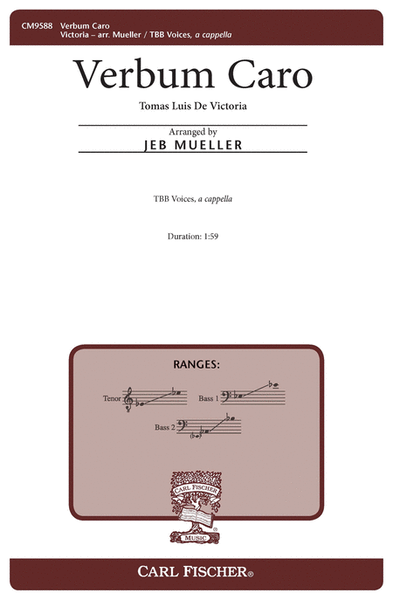
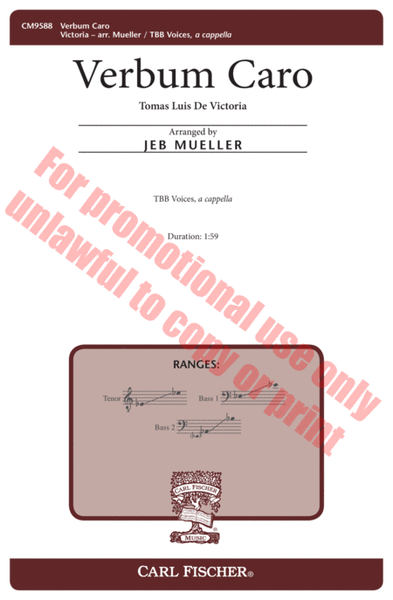
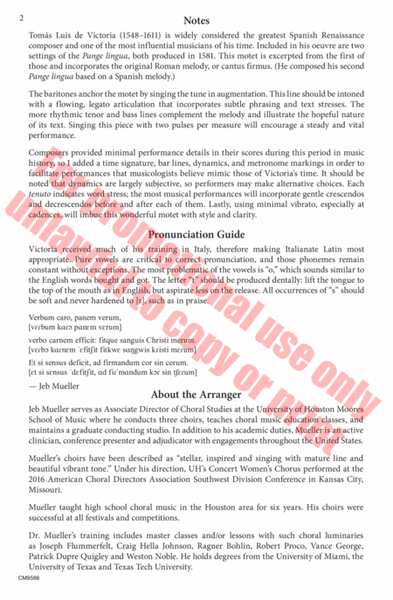
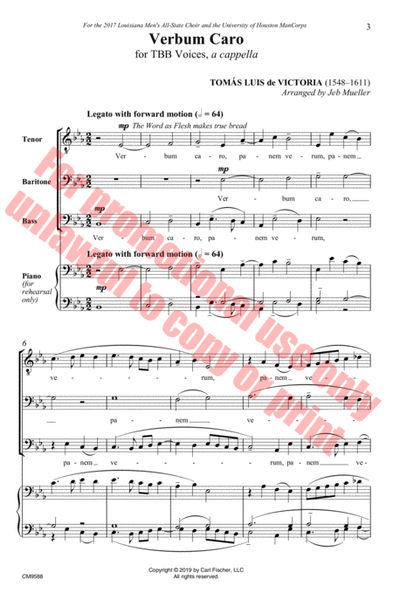
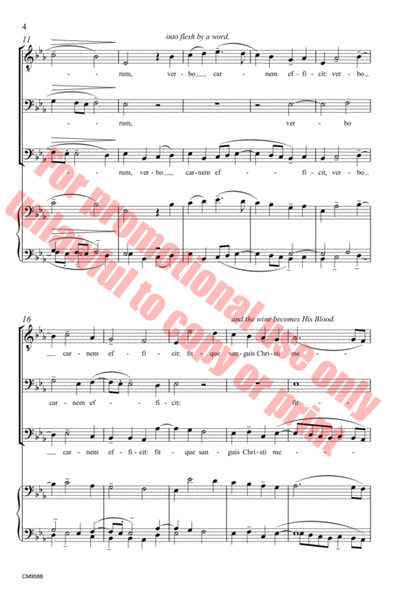

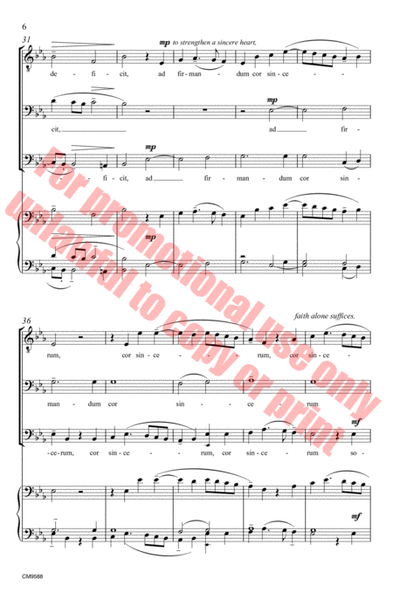
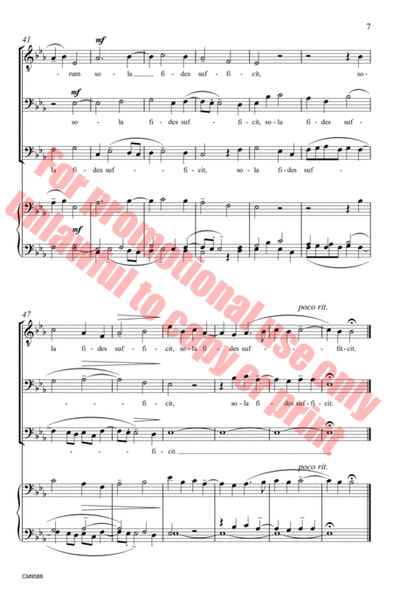
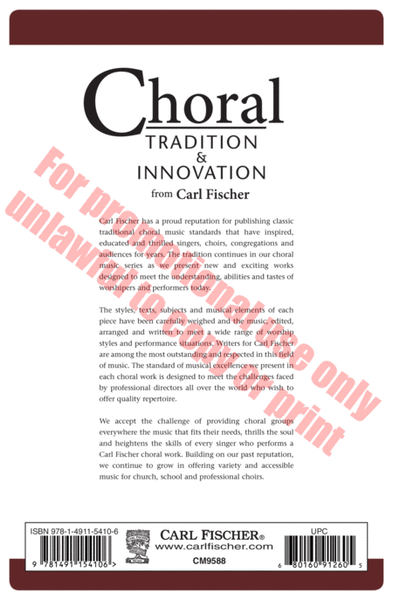
 Share
Share